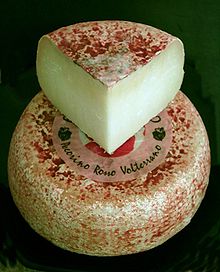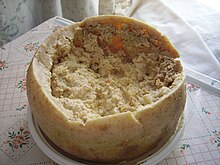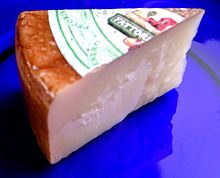Pecorino (cheese)
Pecorino (from Italian pecora , sheep; plural German: pecorinos ) is an Italian cheese that was originally made from pure sheep's milk . Today there are also cheaper varieties with added cow's milk or goat's milk .
Pecorino is a collective name for various sheep's milk cheeses . Every region of Italy has its own variants of Pecorino, some of which can look back on a long history; four types (with partly different sub-varieties e.g. Pecorino Romano del Lazio) are subject to special protection with their respective names as protected designations of origin and are precisely defined.
history
The Pecorino Romano comes from central Italian Lazio . Later, the art of production was passed on to other areas, so that today "romano" refers more to the way it is made, while only a small part of the cheese comes from the area of Rome and larger quantities from other areas, especially from Sardinia as well the younger Pecorino Sardo . Pecorinos have also been made in Sicily since Greek times. With some cheaper cheeses, cow's milk is added, pure sheep's milk cheeses have the addition tutto di latte di pecora or pecora completo . In 1955, two varieties ( Pecorino romano and Pecorino Siciliano ) received the DOP seal and thus protection of origin, then in 1986 the Pecorino Toscano and in 1991 finally the Pecorino sardo . PDO protection has been in effect across Europe for these four (see chapter "Variants") since 1996 . Since Pecorino alone is not a protected name, you can also find so-called Pecorino from Germany and many other countries on the market today.
Manufacture and properties

Pecorino is made from raw milk. The rennet from kid and lamb stomachs is added to the 36 to 38 ° C warmed milk. The clotting time is three quarters of an hour. Then the jelly is cut and the curd is heated and stirred vigorously, depending on the type of cheese, until it has released enough whey to then pour the product into special basket molds, where the dough grows together and creates the later characteristic basket pattern. Now the raw cheese wheels are dipped in heated whey and finally pulled through boiling brine or salted dry to extend the shelf life.
Pecorino is traded fresh, medium-ripe and fully ripened, with a ripening period of three months to one year. The compact dough, which can sometimes have small holes, is white in fresh cheese and straw yellow after ripening. The originally straw-yellow bark also darkens over time. The loaves usually weigh around two kilograms. The young, “fresh” cheese is comparatively soft and tastes very mild; The older and more ripened it gets, the harder the consistency and the more intense and piquant its taste. What all pecorinos have in common is a nutty note and the lemony flavor of sheep cheese. The taste and properties are not unlike Parmigiano Reggiano , which is made from cow's milk.
Around 90 percent of the whey remains in the production of the pecorino, from which ricotta is made.
variants
There are numerous variations of the pecorino. It was originally made from pure sheep's milk, recognizable by the addition of pecora completo or tutto di latte di pecora . Pecorino is also available in different degrees of ripeness, on the other hand there are various regional variants, such as a Sardinian cream cheese variant, smoked or brushed with tomato paste. Other types of cheese are oiled and rubbed with charcoal.
Pecorino Romano, DOP
This cheese has a long tradition and is made from 100% sheep's milk. It tastes aromatic and very spicy. The dough is white or parchment-colored with a dense, heavy structure and a thin, elastic, white or brown rind. An old, fully ripened Pecorino romano is then extremely firm and interspersed with typical cheese crystals, it can taste distinctly piquant and salty. In the 18th century , emigrated cheese masters brought the recipe for making it to Sardinia , and since then the largest amount of Romano has been made there. There is the possibility to add a more precise origin logo to the Pecorino Romano (“Pecorino Romano del Lazio” or “Prodotto in Sardegna” or “Prodotto in Grosseto”). Pecorino Romano is valued both as a table and as a grated cheese.
| Pecorino Romano, PDO / DOP | |
| origin |
Italy ( Roma , Rieti , Viterbo , Latina , Grosseto , Cagliari , Nuoro , Oristano , Sassari ) |
| milk | Sheep / whole milk |
| treatment | Raw milk or thermised |
| Cheese group | Hard cheese |
| Fat i. Tr. | at least 36% |
| Fat absolutely | 31% |
| Protein absolutely | 25% |
| Calcium | 900-950 mg / 100 g |
| Measure / weight | cylindrical, diameter 25–35 cm, height 25–40 cm / 20–35 kg |
| Ripening time | min. 8 months (grated), min. 5 months (not rubbed) |
| Certification |
DOP since October 30, 1955, PDO since June 12, 1996 |
Pecorino Sardo, DOP
Pecorino Sardo, DOP, the third large sheep cheese from the island of Sardinia after the Romano and Fiore Sardo , is relatively young. Made from raw milk or semicotto (the young cheese wheel is briefly dipped in a bath with boiling brine to extend the shelf life), it is traded in two types: as a dolce with a green label, it matures for a shorter time and has a soft dough; it is served fresh as Table cheese or use it in the kitchen; As a maturo with a blue label, it matures longer and is sometimes also smoked, is comparatively hard, salty and dry with a tough, yellowish-white rind. This type is an optimal grated cheese.
In addition to the two official variants, there is also the so-called “ casu marzu ”, literally: 'rotten / rotten cheese', an overripe type of pecorino sardo that contains live maggots and is a very special specialty in Sardinia. The sale of this cheese was illegal for a long time because it was feared that diseases could be transmitted through the fly eggs and the hatching maggots that feed on the cheese and ferment it through their excretions. The cheese was only released again in 2005, whereby the flies required for production now have to be germ-free (i.e. they must not have come into contact with excrement or waste) and the cheese is enriched with bacteria that promote the growth of the maggots.
| Pecorino Sardo, PDO / DOP | |
| origin | Italy ( Cagliari , Nuoro , Oristano , Sassari ) |
| milk | Sheep / whole milk |
| treatment | k. A. |
| Cheese group | Hard cheese |
| Fat i. Tr. | 40% |
| Calcium | k. A. |
| Measure / weight | cylindrical, diameter 24–26 cm, height 15–16 cm / 1.5–9 kg |
| Ripening time | 3–6 months |
| Certification |
DOP since November 4, 1991, PDO since July 1, 1996 |
Pecorino Siciliano, DOP
The cheese was already known in Sicily in the Greek period . After maturing for 4-8 months, the raw milk cheese has a hard, compact texture with an intense aroma. Depending on where it is made, it comes in different subspecies, most of which are equally suitable for the table as well as the kitchen. The rind is yellowish-white with the stamp of the master cheese maker. Young and unsalted, it is known as Tuma , this type is enjoyed on the first day after production, is very soft and creamy and tastes very delicate. After salting it is called Primo Sale , towards the end of the up to two-year maturity it is called then Canistratu (also Canestrato or Incanestrato ) to the typical form and examination by the baskets (ital. Canestre ) arises in which it matures , it then tastes very spicy and salty-hot. Another type of Pecorino Siciliano that has matured for a long time is the Tumazzu. In this case, peppercorns or saffron are added to the cheese in order to underline the characteristic sharp taste.
| Pecorino Siciliano, PDO / DOP | |
| origin |
Italy ( Catania , Enna , Trapani , Caltanissetta , Palermo , Ragusa , Syracuse , Messina , Agrigento ) |
| milk | Sheep / whole milk |
| treatment | k. A. |
| Cheese group | Cream cheese to hard cheese |
| Fat i. Tr. | k. A. |
| Calcium | k. A. |
| Measure / weight | cylindrical, diameter approx. 35 cm, height 10–18 cm / 4–12 kg |
| Ripening time | unripened up to 2 years |
| Certification |
DOP since October 30, 1955, PDO since June 12, 1996 |
Pecorino Toscano, DOP
Pecorino Toscano, DOP goes back to Etruscan cheese art and comes today mainly from Tuscany and the provinces of Perugia and Viterbo . It is said that Pope Pius III was one of the lovers of this cheese . and Lorenzo de Medici . The ripening period ranges from just 20 days for the tenero type to 4 months for the a pasta dura type . Depending on this, the dough is soft to semi-hard, white-yellow in color and has a firm structure. Its pleasant, intense and very characteristic scent differs from the sharp spiciness of the other Pecorinos; it always tastes soft and almost sweet with aromatic spice, even after a long period of ripening. Its bark is yellow in shades from golden yellow to parchment-colored. It is usually enjoyed young and hardly ripened when it is still almost creamy as a table cheese, but it can age just as well and be used as grated cheese.
| Pecorino Toscano, PDO / DOP | |
| origin |
Italy ( Arezzo , Pisa , Massa Carrara , Livorno , Grosseto , Firenze , Prato , Lucca , Pistoia , Siena , Terni , Perugia , Viterbo ) |
| milk | Sheep / whole milk |
| treatment | k. A. |
| Cheese group | semi-hard cheese - hard cheese |
| Fat i. Tr. | k. A. |
| Calcium | k. A. |
| Measure / weight | cylindrical, diameter 15–22 cm, height 7–11 cm / 1–3 kg |
| Ripening time | 20 days to 4 months |
| Certification |
DOP since May 17, 1986, PDO since July 1, 1996 |
Further
- Pecorino fresco has an unripened, white dough, is rather crumbly and tastes quite mild and slightly sour.
- Pecorino senese , also from Tuscany , is brushed with tomato puree.
- Pecorino di Filiano DOP from Basilicata .
use
Depending on the ripening and type, the Pecorino is suitable for enjoyment in many ways. Young pecorino is often served as part of a cheese platter or consumed with olive bread , radicchio and plum tomatoes as a snack. In Seadas it is used as part of a dessert. It is often sliced with strips of sun-dried tomatoes and served drizzled with extra virgin olive oil . Aged pecorino is mainly used as grated cheese and is used in many dishes in southern Italian cuisine; its piquant aroma is used to season fillings for mushrooms, tomatoes and other vegetables. A well- developed red wine is a popular companion drink for all Pecorinos.
literature
- Waldemar Ternes , Alfred Täufel, Lieselotte Tunger, Martin Zobel (eds.): Food lexicon . 4th, comprehensively revised edition. Behr, Hamburg 2005, ISBN 3-89947-165-2 . , Page 1373
- Brochure: Cheese from Italy. Droemer Knaur 1999. ISBN 3-426-27161-3 .
Web links
- Page of the Consorzio per la tutela del formaggio pecorino romano , richly illustrated, with detailed information on the history, production and use of the Pecorino romano. (Italian, English, French, German)
- ISMEA website ( Memento from May 20, 2012 in the Internet Archive ) (de)
- Modifica del disciplinare di produione della denominazione "Pecorino Romano" registrata in qualita 'di denominazione di origine protetta in forza al regolamento CE n.1107 della Commissione del 12 giugno 1996. (09A13755) , pecorinoromano.com, accessed January 15, 2018
Individual evidence
- ↑ Entry in Duden
- ↑ a b c d DOOR (Agriculture and Rural Development) database of the European Commission on all protected Pecorinos , on ec.europa.eu, accessed on May 31, 2017




